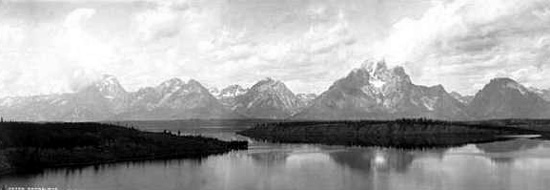

Panoramic view of the Grand Tetons, 1902.

Cunningham Cabin, Spread Creek.
The cabin was built in approximately 1888. Built in a "dog trot" fashion, it is located at Spread Creek about 25 miles north of
Jackson and was owned by Pierce Cunningham. Cunningham arrived in the valley in the early 1880's from
New York. During the winter of 1892-93, the cabin was occupied by three men,
George Spenser, Mike Burnett, and "Swede" Jackson. Swede was a partner of Cunningham's and
had been delegated the duty of keeping an eye on the other two by Cunningham who, perhaps,
suspected that Spenser and Burnett made their living by selling horses with defective
titles. In April of 1893, Spenser stepped out of the cabin and near the corral was confronted by
a posse from Idaho led by A. A. Anderson. In the ensuing shoot-out, Spenser ended up dead. The posse then turned
its attention to the cabin. There, Burnett found a similar fate. Spenser and Burnett were buried near the corner of the corral. Later
badgers dug up the bones and spread them about. Two years later the cabin was used as a
fort during the Indian Scare of 1895.
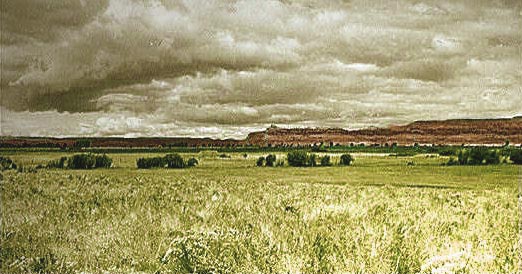
Jackson Hole, 1941.
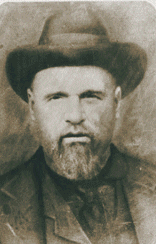 Nick Wilson Nick Wilson
In 1889, Elija Nickols "Nick" Wilson (1845-1916), a former Pony Express rider and Overland Stage driver guided
a company of L.D.S. into the valley. At the age of 9, Wilson had been adopted by Chief
Washakie's mother. Thus, Wilson was a adoptive brother of Chief Washakie. Wilson first came through
the valley at age 12 with a company of Shoshoni. He was employed by the Pony Express at age
15. The village of Wilson is named after him. There, Wilson with his son-in-law operated a hotel, store and saloon.
Others ventured into the valley. Charles J. Allen (1853-1937) arrived in the valley from Idaho and established a cattle business.
In 1892 he constructed a grocery store and post office at Moran. He wife was appointed as Postmaster. He also
constructed a log hotel.
Frank V. Lovell (1864-1937) arrived at Moran about 1895. In 1903, he sold out to Benjamin Sheffield.
Sheffield in turn established a hunting lodge which replaced an earlier hotel which had been
established by Ed "Cap" Smith. Sometime following 1907, Lovell left the area for Portland, Oregon.
Originally Moran was located with a view of Jackson Lake. In 1916, the lake was deepened by the construction of a dam which obscured the
view of the Lake. Thus, some of Sheffield's original property was condemned by the Federal Government. As compensation he was given
replacement lands. The main lodge building burned in 1935. Sheffield was, among other things, a friend of the horse thief Ed Harrington. Harrington actually went under
two different names, Ed Harrington and Ed H. Trafton. Under the name Trafton, in 1914 he successfully pulled off the robbery of
15 tourist coaches in Yellowstone in one day. Shortly after the robbery, "Harrington" disappeared from the area. He was
caught a year later when his wife turned him in after he had an affair with a neighbor.
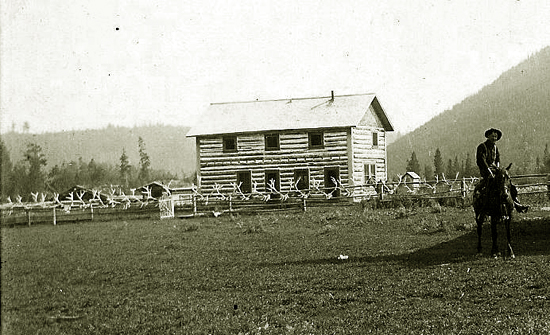
Charles J. Allen's Hotel, Moran, Wyoming, undated.
In 1916, Yellowstone Park superintendent, Horace Albright, visited Jackson Hole for the first time. The road had been flooded out
by the rising waters from the constrcution of the new dam. Thus, Albright's motor car was forced to follow an "Elk Trail" through
the woods and underbrust to get to Moran. Sheffield's dining room had burned down, and thus meals were served in a tent.
Albright was impressed, however, by the steaks and the "cowboy breakfast" he had the next morning. See
Horace M. Albright and Marian Albright Schenck, Creating the National Park Service: The Missing Years,
University of Oklahoma Press, 1999.
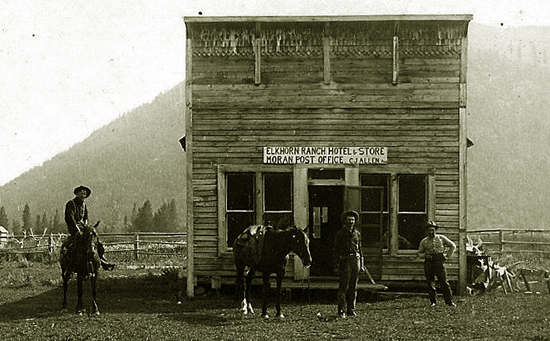
Post Office and store, Moran, Wyoming, undated.
Later Superintendent Albright again visited Sherffield's and ventured further south to Jackson. He was less than
impressed:
"Jackson Lake had long since been dammed where the Snake River exited southward.
This had caused a ghastly eyesore of dead trees as far as the eye could reach and
had polluted the water. There were ugly buildings at Moran, saloons near Jenny Lake,
a rundown old town sprawling across the end of the valley, cattle everywhere."
The "rundown old town" was Jackson. Albright continued:
" I'll tell you, it was a jolt. Sheffield had made out that it was a town.
Well, a town is not a city, but a town should be more than a haphazard crisscross
of rutted streets, a cluster of shaggy buildings, with no hint of respectability
except for an old church."
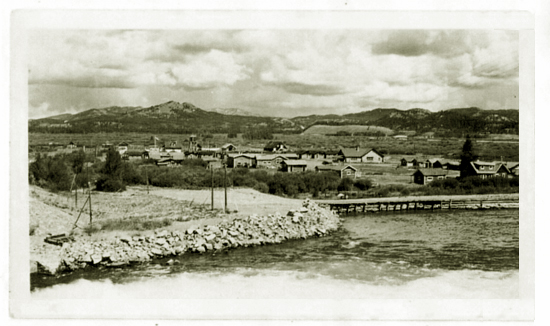
Moran, Wyoming, undated, photo by Harrison "Hank" Crandall .
In 1955, it was announced that the old Jackson Lake Lodge would be demolished and replaced by a new, modern multi-storied,
concrete edifice. The new hotel, in Disneyesque fashion, used wooden forms which would give the concrete the
appearance of wood grain. The construction of the new resort would also required the relocation of the town of
Moran. At the time, Moran had a general store, restaurant, gas station, post office,
photo studio, and about 110 log houses. Over the next several years, the various buildings, including Frank
Lovell's original cabin, were dismantled and hauled awat to a new
location about five miles away on Colter Bay. Thus, there remains a Moran, Wyoming, but it is not
Moran.
Moran was not the only area that received the approbation of those interested in restoring Jackson's Hole to a
wilderness.
In 1918, James H. Manges, proved up his homestead near Moose. His homestead proved not to be profitable and in
1926 he sold out to Chester Goss, a Los Angeles business promoter. Goss also bought out the Bassette homesteads.
Goss established on his new purchase a tourist resort conisting of cabins, store, baseball diamond, and rodeo grounds. A billboard
advertised the facility, named the "Elbo Ranch," as the "Home of the Hollywood Cowboy." Nearby were also establsihed a
dance hall and an illegal gin mill.
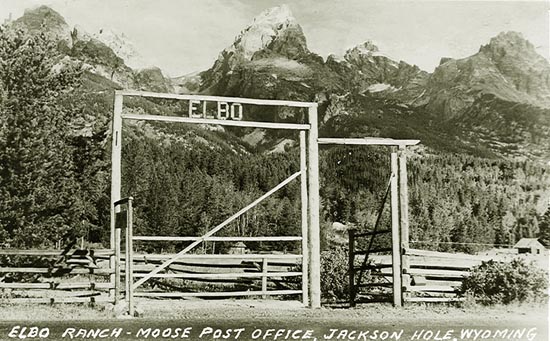
Entrance to Elbo Ranch, 1920's.
In the hearings before Congress on the expansion of the Grand tetons National Park, the
Elbo Ranch was cited as being "out of harmony" with the area. In 1929, Goss sold out to the Snake River Land Company. The
area occuppied by the Elbo was acquired by the Park Service in 1956 and in 1973, the barn, cabins, and bridge were removed by the
Park Service. Only the Manges cabin was left. The Manges cabin is somewhat unique as having two stories.
Next Page: Menor's Ferry.
|